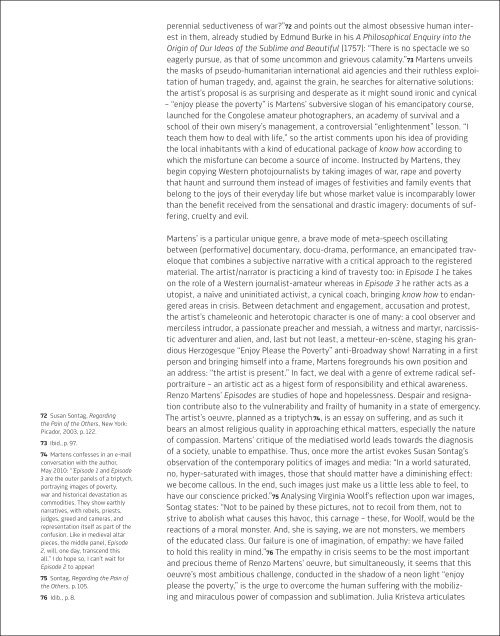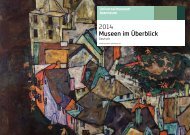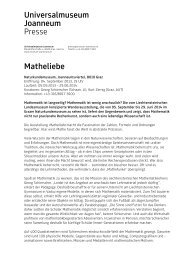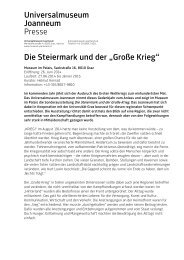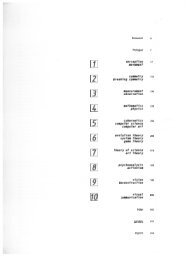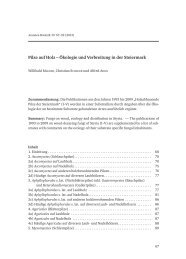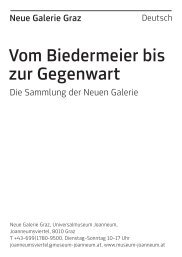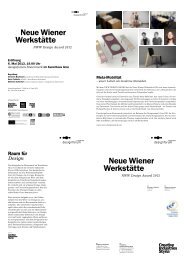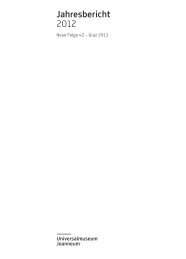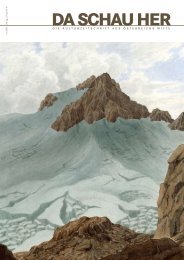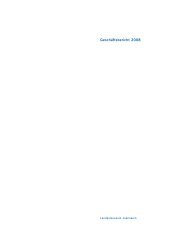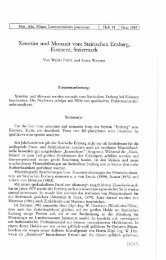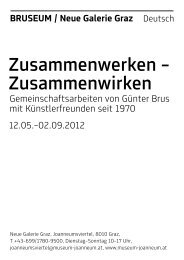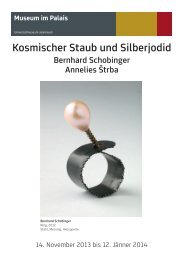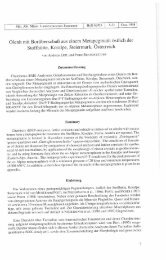Human Condition - Universalmuseum Joanneum
Human Condition - Universalmuseum Joanneum
Human Condition - Universalmuseum Joanneum
Sie wollen auch ein ePaper? Erhöhen Sie die Reichweite Ihrer Titel.
YUMPU macht aus Druck-PDFs automatisch weboptimierte ePaper, die Google liebt.
72 Susan Sontag, Regarding<br />
the Pain of the Others, New York:<br />
Picador, 2003, p. 122.<br />
73 Ibid., p. 97.<br />
74 Martens confesses in an e-mail<br />
conversation with the author,<br />
May 2010: “’Episode 1 and Episode<br />
3 are the outer panels of a triptych,<br />
portraying images of poverty,<br />
war and historical devastation as<br />
commodities. They show earthly<br />
narratives, with rebels, priests,<br />
judges, greed and cameras, and<br />
representation itself as part of the<br />
confusion. Like in medieval altar<br />
pieces, the middle panel, Episode<br />
2, will, one day, transcend this<br />
all.” I do hope so, I can’t wait for<br />
Episode 2 to appear!<br />
75 Sontag, Regarding the Pain of<br />
the Others, p. 105.<br />
76 Idib., p. 8.<br />
perennial seductiveness of war?”72 and points out the almost obsessive human interest<br />
in them, already studied by Edmund Burke in his A Philosophical Enquiry into the<br />
Origin of Our Ideas of the Sublime and Beautiful (1757): “There is no spectacle we so<br />
eagerly pursue, as that of some uncommon and grievous calamity.”73 Martens unveils<br />
the masks of pseudo-humanitarian international aid agencies and their ruthless exploitation<br />
of human tragedy, and, against the grain, he searches for alternative solutions:<br />
the artist’s proposal is as surprising and desperate as it might sound ironic and cynical<br />
– “enjoy please the poverty” is Martens’ subversive slogan of his emancipatory course,<br />
launched for the Congolese amateur photographers, an academy of survival and a<br />
school of their own misery’s management, a controversial “enlightenment” lesson. “I<br />
teach them how to deal with life,” so the artist comments upon his idea of providing<br />
the local inhabitants with a kind of educational package of know how according to<br />
which the misfortune can become a source of income. Instructed by Martens, they<br />
begin copying Western photojournalists by taking images of war, rape and poverty<br />
that haunt and surround them instead of images of festivities and family events that<br />
belong to the joys of their everyday life but whose market value is incomparably lower<br />
than the benefit received from the sensational and drastic imagery: documents of suffering,<br />
cruelty and evil.<br />
Martens’ is a particular unique genre, a brave mode of meta-speech oscillating<br />
between (performative) documentary, docu-drama, performance, an emancipated traveloque<br />
that combines a subjective narrative with a critical approach to the registered<br />
material. The artist/narrator is practicing a kind of travesty too: in Episode 1 he takes<br />
on the role of a Western journalist-amateur whereas in Episode 3 he rather acts as a<br />
utopist, a naïve and uninitiated activist, a cynical coach, bringing know how to endangered<br />
areas in crisis. Between detachment and engagement, accusation and protest,<br />
the artist’s chameleonic and heterotopic character is one of many: a cool observer and<br />
merciless intrudor, a passionate preacher and messiah, a witness and martyr, narcissistic<br />
adventurer and alien, and, last but not least, a metteur-en-scène, staging his grandious<br />
Herzogesque “Enjoy Please the Poverty” anti-Broadway show! Narrating in a first<br />
person and bringing himself into a frame, Martens foregrounds his own position and<br />
an address: “the artist is present.” In fact, we deal with a genre of extreme radical sefportraiture<br />
– an artistic act as a higest form of responsibility and ethical awareness.<br />
Renzo Martens’ Episodes are studies of hope and hopelessness. Despair and resignation<br />
contribute also to the vulnerability and frailty of humanity in a state of emergency.<br />
The artist’s oeuvre, planned as a triptych 74, is an essay on suffering, and as such it<br />
bears an almost religious quality in approaching ethical matters, especially the nature<br />
of compassion. Martens’ critique of the mediatised world leads towards the diagnosis<br />
of a society, unable to empathise. Thus, once more the artist evokes Susan Sontag’s<br />
observation of the contemporary politics of images and media: “In a world saturated,<br />
no, hyper-saturated with images, those that should matter have a diminishing effect:<br />
we become callous. In the end, such images just make us a little less able to feel, to<br />
have our conscience pricked.”75 Analysing Virginia Woolf’s reflection upon war images,<br />
Sontag states: “Not to be pained by these pictures, not to recoil from them, not to<br />
strive to abolish what causes this havoc, this carnage – these, for Woolf, would be the<br />
reactions of a moral monster. And, she is saying, we are not monsters, we members<br />
of the educated class. Our failure is one of imagination, of empathy: we have failed<br />
to hold this reality in mind.”76 The empathy in crisis seems to be the most important<br />
and precious theme of Renzo Martens’ oeuvre, but simultaneously, it seems that this<br />
oeuvre’s most ambitious challenge, conducted in the shadow of a neon light “enjoy<br />
please the poverty,” is the urge to overcome the human suffering with the mobilizing<br />
and miraculous power of compassion and sublimation. Julia Kristeva articulates


